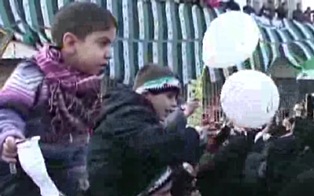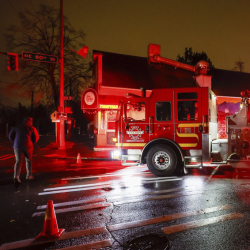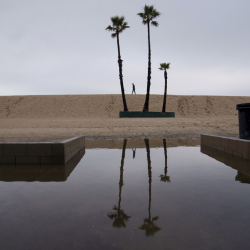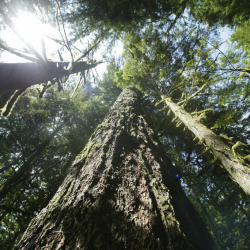 BEIRUT (AP) -- A French photojournalist and a prominent American war correspondent working for a British newspaper were killed Wednesday as Syrian forces intensely shelled the opposition stronghold of Homs. President Bashar Assad's regime also escalated attacks on rebel bases elsewhere, with helicopter gunships strafing areas in the northwest, activists said.
BEIRUT (AP) -- A French photojournalist and a prominent American war correspondent working for a British newspaper were killed Wednesday as Syrian forces intensely shelled the opposition stronghold of Homs. President Bashar Assad's regime also escalated attacks on rebel bases elsewhere, with helicopter gunships strafing areas in the northwest, activists said.
Weeks of withering barrages on the central city of Homs have failed to drive out opposition factions that include rebel soldiers who fled Assad's forces. Hundreds have died in the siege and the latest deaths further galvanized international pressure on Assad, who appears intent on widening his military crackdowns despite the risk of pushing Syria into full-scale civil war.
"This tragic incident is another example of the shameless brutality of the Assad regime," U.S. State Department spokeswoman Victoria Nuland said of the journalists killed.
The Obama administration opened the door slightly Tuesday to international military assistance for Syria's rebels, with officials saying new tactics may have to be explored if Assad continues to defy pressure to halt a brutal crackdown on dissenters that has raged for 11 months and killed thousands.
The White House and State Department said they still hope for a political solution. But faced with the daily onslaught by the Assad regime against Syrian civilians, officials dropped the administration's previous strident opposition to arming anti-regime forces. It remained unclear, though, what, if any, role the U.S. might play in providing such aid.
France was outraged over the journalists killed.
"That's enough now, the regime must go," said French President Nicolas Sarkozy.
French spokeswoman Valerie Pecresse identified those killed as French photojournalist Remi Ochlik, 28, and American reporter Marie Colvin, who was working for Britain's Sunday Times.
France's Foreign Minister, Alain Juppe, said the attacks show the "increasingly intolerable repression" by Syrian forces. French Communication Minister Frederic Mitterrand said of the journalists killed: "It's abominable."
Syrian activists said at least two other Western journalists - French reporter Edith Bouvier of Le Figaro and British photographer Paul Conroy of the Sunday Times - were wounded in Wednesday's shelling, which claimed at least 13 lives.
Syria's stalwart ally and major arms supplier, Russia, remained behind Assad, but said the bloodshed adds urgency for a cease-fire to allow talks between his regime and opponents.
The Syrian military has intensified its attacks on Homs in the past few days, aiming to retake rebel-held neighborhoods that have become powerful symbols of resistance to Assad's rule. For the government in Damascus, Homs is a critical battleground to maintain its control of Syria's third-largest city and keep more rebel pockets from growing elsewhere.
In the northwestern province of Idlib, a main base of the rebel Free Syrian Army, the Britain-based Syrian Observatory for Human Rights claimed that Syrian military helicopters fitted with machine guns strafed the village of Ifis. Syrian combat helicopters are primarily Russian-made, though they also have a number of French choppers.
Another opposition group, the Local Coordination Committees, said troops conducted raids in the Damascus district of Mazzeh district and the suburb Jobar, where dozens of people were detained. In Jobar, the group said troops broke doors of homes and shops and set up checkpoints.
The group also said troops backed by tanks stormed the southern village of Hirak and conducted a wave of arrests.
A Homs-based activist, Omar Shaker, said the journalists were killed when several rockets hit a garden of a house used by activists and journalists in the besieged Homs neighborhood of Baba Amr, which has come under weeks of heavy bombardment by forces from Assad's regime. At least 13 people were killed in Wednesday's shelling, including the journalists, activists said.
The U.N. estimates that 5,400 people have been killed in repression by the regime of President Bashar Assad against a popular uprising that began 11 months ago. Syrian activists, however, put the death toll at more than 7,300.
Shaker said tanks and artillery began intensely shelling at 6:30 a.m. and was continuing hours later. He said the apartment used by journalists was hit around 10 a.m.
The intense shelling in parts of Homs - with blasts occurring sometimes just a few second apart - has appeared to be indiscriminate over the past week, hitting homes and streets randomly. Some suggested, however, that the house used by the journalists and activists was pinpointed by Syrian gunners.
The French culture minister Mitterrand claimed the journalists were "pursued" as they tried to find cover, but gave no elaboration. A campaigner for online global activist group Avaaz, Alice Jay, claimed the group was "directly targeted."
An amateur video posted online by activist showed what they claimed were bodies of two people in the middle of a heavily damaged house. It said they were of the journalists. One of the dead was wearing what appeared to be a flak jacket.
Another amateur video shows the two injured journalists in a makeshift clinic, lying on two separate beds. The French journalist, Bouvier had her left leg tied from the thigh down in a cast. A doctor in the video explains that she needs emergency medical care. Conroy appears in the video and the doctors say he has deep gashes in his left leg.
Many foreign journalists have been sneaking into Syria illegally in the past months with the help of smugglers from Lebanon and Turkey. Although the Syrian government has allowed some journalists into the country their movement is tightly controlled by Information Ministry minders.
Colvin, from Oyster Bay, New York, was in her 50s and a veteran foreign correspondent for Britain's Sunday Times for the past two decades. She was instantly recognizable for an eye patch worn after being injured covering conflicts in Sri Lanka in 2001.
Colvin said she would not "hang up my flak jacket" even after the eye injury.
"So, was I stupid? Stupid I would feel writing a column about the dinner party I went to last night," she wrote in the Sunday Times after the attack. "Equally, I'd rather be in that middle ground between a desk job and getting shot, no offense to desk jobs.
In Geneva, the International Red Cross said it was holding talks with members of the opposition Syrian National Council. The ICRC called Tuesday for a daily two-hour halt to fighting in Syria so it can bring emergency aid to affected areas and evacuate the wounded and sick.
Head of ICRI operations for the Middle East, Beatrice Megevand-Roggo, told The Associated Press on Tuesday that the ICRC had almost no contacts with opposition figures inside Syria.
The journalists' deaths came a day after a Syrian sniper shot dead Rami al-Sayyed, a prominent activist in Baba Amr who was famous for posting online videos, Shaker and the Local Coordination Committees activist group said.
On Jan. 11, award-winning French TV reporter Gilles Jacquier was killed in Homs. The 43-year-old correspondent for France-2 Television was the first Western journalist to die since the uprising began in March. Syrian authorities have said he was killed in a grenade attack carried out by opposition forces - a claim questioned by the French government, human rights groups and the Syrian opposition.
Last week, New York Times correspondent Anthony Shadid died of an apparent asthma attack in Syria after he sneaked in to cover the conflict.
---
Associated Press reporter Matthew Lee contributed to this report.
---
Bassem Mroue can be reached on twitter at http://twitter.com/bmroue
© 2012 The Associated Press. All rights reserved. This material may not be published, broadcast, rewritten or redistributed. Learn more about our Privacy Policy and Terms of Use.
Portland and Seattle
Free Subscription to Breaking News
Free Subscription to Breaking News























































































































































































































































































































































